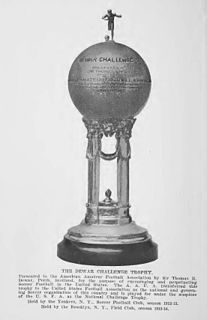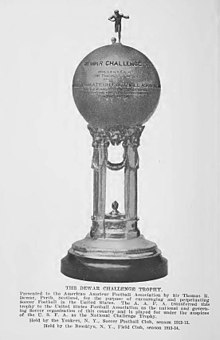The ATP Challenger Tour, known until the end of 2008 as the ATP Challenger Series, is a series of international men's professional tennis tournaments. The Challenger Tour events are the second-highest tier of tennis competition, behind the ATP Tour. The ITF World Tennis Tour tournaments are on the entry-level of international professional tennis competition. The ATP Challenger Tour is administered by the Association of Tennis Professionals. Players who succeed on the ATP Challenger Tour earn sufficient ranking points to become eligible for main draw or qualifying draw entry at ATP Tour tournaments. Players on the Challenger Tour are usually young players looking to advance their careers, those who fail to qualify for ATP events, or former ATP players looking to get back into the big tour.
The 1913–14 National Challenge Cup was the first season that the modern-day Lamar Hunt U.S. Open Cup formed. Brooklyn Field Club won the title.
The 1915–16 National Challenge Cup was the third tournament of the modern-day Lamar Hunt U.S. Open Cup. Bethlehem Steel won its second consecutive championship. The entries for the competition were to be made by midnight September 30, 1915. The draw for the qualifying and first rounds was made on October 2, 1915. The tournament schedule was originally set for the qualifying round to take place on or before October 24; first round, November 14; second round, December 12; third round, January 16, 1916; fourth round, March 5; semis, April 2, and final on April 30.

Thomas Florie was an American soccer forward. He played in both the first and second American Soccer Leagues, winning two National Challenge Cup titles. Florie was also a member of the United States men's national soccer team at the 1930 and 1934 FIFA World Cup. He was inducted into the U.S. National Soccer Hall of Fame in 1986.
Thomson Ferrans was a U.S.-Scottish soccer defender. Ferrans earned three caps with the U.S. national team in 1937.
Frankie "Shorty" Moniz(misspelled Muniz and Munitz) was a U.S. soccer player who spent six seasons in the American Soccer League and earned two caps with the U.S. national team.
Adolph "Ed" C. Czerkiewicz(listed in some sources as Czerchiewicz) was an American soccer right fullback who spent eight seasons in the American Soccer League and was a member of the United States national team at the 1934 FIFA World Cup.
Malcolm Goldie was a Scottish-American soccer outside left who began his career in Scotland before moving to American Soccer League in 1922. He earned one cap with the U.S. national team in 1925. He also coached the MIT soccer team from 1933 to 1941.
The 1916–17 National Challenge Cup was the fourth annual cup tournament held by the United States Football Association. On May 5, 1917, Fall River Rovers defeated Bethlehem Steel to take the title. Thomas Swords scored the game-winning goal thirty seconds into the game. The second round match on January 28 between Bay Ridge of Brooklyn and the Newark Scottish-Americans was originally awarded to Bay Ridge for non-appearance of the Scots. Despite Bay Ridge having played and won their third-round game 2-0 over New York, the Bay Ridge/Scots game was ordered replayed by the cup committee. The Scots won the replay and went on to face New York in the third round.
The 1918 American Cup was the annual open cup held by the American Football Association. Twenty nine teams began the tournament which culminated in Bethlehem's third straight championship.
The 1933 National Challenge Cup was the annual open cup held by the United States Football Association now known as the Lamar Hunt U.S. Open Cup. As in 1931, the ASL teams played a round robin format instead of direct knockout games. The five New York teams formed the Metropolitan group. The New England group included the three remaining ASL teams along with Victoria Mills of the Southern New England Association who qualified by defeating Fairlawn Rovers. The Round Robin was somewhat unpopular because of the methods used. Despite a league setup, games tied at the end of regulation were to go into overtime. In the event of a tie in the standings, goal average was used to break the tie. A slight controversy ensued when a game between Boston and Fall River was called at the 78th minute with the score 0-0. Fall River later forfeited the replay leaving Boston tied for first with Pawtucket. The Rangers advanced on better goal average leaving Boston unable to make up the difference in a replay with Fall River or a playoff with Pawtucket. In the West it was business as usual with the standard knockout procedure and the Stix of St. Louis making their second of what would be six consecutive trips to the national final. Other highlights include Bert Patenaude's five goal performance against Fairhill in the First German Club's first round match on January 14.
The 1934 National Challenge Cup was the annual open cup held by the United States Football Association now known as the Lamar Hunt U.S. Open Cup.
The 1935 National Challenge Cup was the annual open cup held by the United States Football Association now known as the Lamar Hunt U.S. Open Cup.
The 1947 National Challenge Cup was the 33rd edition of the United States Soccer Football Association's annual open cup. Today, the tournament is known as the Lamar Hunt U.S. Open Cup. Teams from the American Soccer League II competed in the tournament, based on qualification methods in their base region. Ponta Delgada S.C. won the tournament for their first time ever, by defeating Chicago Sparta.
The 1950 National Challenge Cup was the 36th edition of the United States Soccer Football Association's annual open cup. Today, the tournament is known as the Lamar Hunt U.S. Open Cup. Teams from the American Soccer League II competed in the tournament, based on qualification methods in their base region. St. Louis Simpkins-Ford won the tournament for their second time, by defeating Ponta Delgada S.C. of Fall River, Massachusetts.

The 1942 National Challenge Cup was the 29th edition of the United States Football Association's annual open cup. Today, the tournament is known as the Lamar Hunt U.S. Open Cup. Teams from the American Soccer League II competed in the tournament, based on qualification methods in their base region.

The 1943 National Challenge Cup was the 30th edition of the United States Football Association's annual open cup. Today, the tournament is known as the Lamar Hunt U.S. Open Cup. Teams from the American Soccer League II competed in the tournament, based on qualification methods in their base region.
The Lamar Hunt U.S. Open Cup is an American soccer competition open to all United States Soccer Federation affiliated teams, from amateur adult club teams to the professional clubs of Major League Soccer. The following is the history of the U.S. Open Cup tournament.
The 2019 PGA Tour was the 104th season of the PGA Tour, and the 52nd since separating from the PGA of America. The season began on October 4, 2018. The 2019 FedEx Cup Playoffs begun on August 8, and concluded on August 25, 2019, with Rory McIlroy winning his second FedEx Cup title.
The 2021 Lamar Hunt U.S. Open Cup tournament proper was to feature teams from all five tiers of the men's American soccer pyramid.


